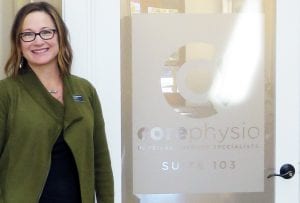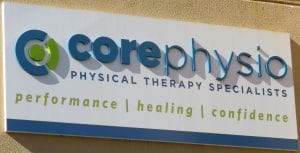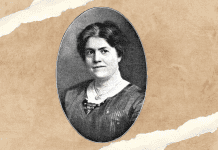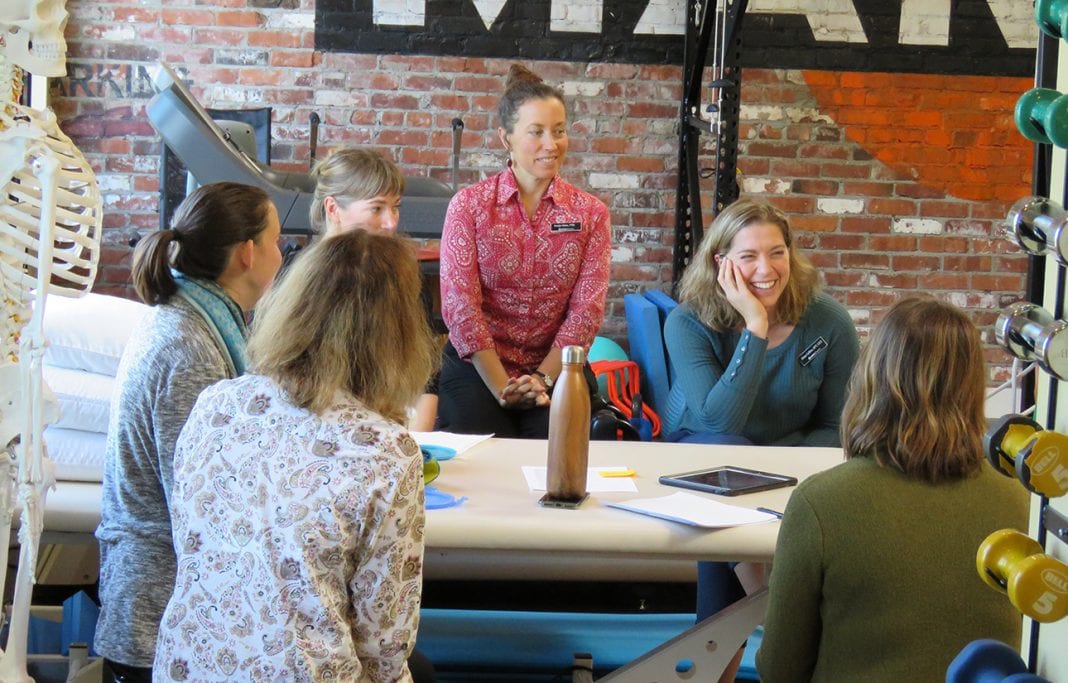When Elizabeth Hampton, owner of Fairhaven’s CorePhysio, joined the physical therapy industry 31 years ago, things were different. “We had the freedom to customize the amount of time we spent with each client depending on the complexity of their needs,” she explains. “There were few insurance hoops to jump through.”

Now, insurance-funded healthcare is driving care to be delivered in much shorter periods of time. The appropriate drive for value, when taken to an extreme, is resulting in risky trade-offs. To reduce costs, many plans limit the amount of time providers can spend with a client. This is what Hampton calls “NASCAR Healthcare,” and she says it not only affects the healthcare industry, but everyone who has or will ever use it.
“Imagine a pit stop at a car race,” she says. “The car pulls rapidly into the pit and a group of mechanics run out. They change the tires, jack the car up, put the wheels back on, and off they go. The trick is, the faster they do it, the faster a person can get back into the race.”
Sounds great for a car, but it’s not a good approach for everything.
“If you’re a car in a race, or if you’re a person with a simple problem to solve, that could work really well,” Hampton says, “but all humans don’t work that way; there is no substitute for feeling like you are heard, understood and important, especially if you’re scared or unsure of what is going on with your body. Because humans need time to connect, communicate what is important to them and also ask clarifying questions to make sure they understand.” Even the most efficient, brilliant health care provider can deliver subpar care if they’re rushed to make big decisions too quickly.
Rather than rushing their clients in and out the door, CorePhysio invests time to enable human connection.

“An initial evaluation subjective may take 10 minutes, or it may take 30, depending on what the client wants and needs to say,” says Caitlin Ford PT DPT OCS. “I don’t like to rush clients through the process, because we’re establishing a relationship built on trust and understanding.”
“I love to have the time to connect with my clients at a personal level,” says Pelvic Health Physical Therapist, Christine Eardley PT, GCS, BCB-PMD. “The bonding between physical therapist and client allows for open communication and honesty.”
Enabling the physical therapist to design the right plan for each client is ideal. Behind the scenes, it can take up to 58 minutes of administrative time to meet insurance rules for each visit. In all healthcare businesses, insurance rules have increased the complexity and workload for behind-the-scenes skilled support team. Customized schedule design, billing, authorizations and medical records management are all a critical part of delivering healthcare well. Hampton added, “Our reception and billing staff get rave kudos from clients, because of their kindness and hard work to ensure that we follow the insurance rules precisely to get client care covered.”
Some folks may prefer – and thrive – with a 30-minute appointment, but it should be decided by the physical therapist and client, not their health insurance. “More insurance companies are saying, ‘You know what? I’ll just give you three visits at a time, and you need to fill out reports, online forms and set up a phone meeting with our case reviewer if you need more visits.’” Hampton says. Every day, she and her staff are advocates fighting for their clients to get the care they need.

Insurance companies’ emphasis on shorter visits can encourage other practices to engage in things like double-booking, where they put one client on a machine while they work with another on a nearby table. Or, to shorten an appointment duration to help meet demand. Most, it seems, walk careful lines trying to do the best by their clients while cutting costs through some combination of these and other strategies.
It’s a complex situation and Hampton is fast to defend their efforts as well as the intentions of Medicare and insurance companies, saying they aren’t an enemy. “If I’m paying for something as a consumer, I want to make sure it’s a good value, it’s a good product and there’s consistent quality,” she says. Hampton emphasizes that finding value in health care is absolutely essential. “There is a certain amount of time you need to dedicate to a client experience for it to be meaningful and effective,” she says.
The goal at CorePhysio is to connect with the patient and do what’s best for them. “We dedicate time to be an active listener and set specific goals with one-on-one treatment tailored to the individual,” says Ford. “As a whole, the company is focused on continuing education and learning the most effective techniques to help. We have genuine empathy for others and love sharing the passion for what we do.”
“Our clients know they can connect with us, too, and feel comfortable to reach out with concerns or questions,” Eardley says. “We make the time to listen. It’s fun to get to know about their lives, including their partners, kiddos and pets! Since we’re one-on-one, I get to completely focus on my client’s care, not worry about what another client is doing if I had to dovetail care.”

Hampton recalls a client she once saw with complex pelvic pain. “Pelvic pain is complicated,” she says. “You need to know the urologic, sexual and colorectal systems, orthopedics, pain neuroscience, biomechanics and detailed past medical history.”
The client had been referred to Hampton by a specialist physician at Pacific Northwest Urology. Because of the complexity of the case and the client’s needs, Hampton chose to see her for an extended time at that initial visit. Providing informed consent and time for clients to ask questions, is critical for clients to feel safe and comfortable and earn their permission for treatment.
“Her husband was there and they both had a lot of questions,” Hampton recalls. “They flew in from out-of-state for this specialty care and were so stressed and fearful. A lot of red flags had been ruled out by Dr. Casperson, and there were still a lot of systems I had to understand.”
But the client’s insurance company said Hampton could only spend 45 minutes with the patient.
“I can’t figure a significantly complex case out in an hour – and I’ve done this for a long time – because I’m not a computer,” says Hampton, who is a Board Certified Clinical Specialist and faculty for Herman and Wallace Pelvic Rehabilitation Institute. “We both needed time to ask clarifying questions and for us to get key information to understand her body; to develop – and deliver – a meaningful treatment plan for her.”
So, Hampton extended her visit to get the information needed, because it was the right thing to do. “And she’s doing really well, by the way,” she continues. “We found out what her contributing factors were. If I had said, ‘Your insurance company won’t cover more than 45 minutes, so you’ll have to come back next week,’ I wouldn’t have been able to help her – and reduce her fear – as quickly. I wouldn’t have understood all of the pieces.”
This value distinction is essential to Hampton. “One choice we have not made as an organization, and we will not make as an organization, is to force care to happen too fast. One thing we do that’s unique is that we spend 40 minutes of one-to-one time, and adjust as needed for each client’s needs. We don’t double-book.”
And their method is working well. CorePhysio’s client satisfaction and functional outcomes are commonly higher than regional or national benchmarks, and they deliver care at a competitive price point, proving that great PT care doesn’t have to cost more.

More and more clients, in fact, are choosing to pay for their care and stay completely outside of their insurance altogether. “There may be a point where we have to fire some insurance companies,” says Hampton, “if agreeing to their contract requires us to compromise our values in the care we provide.”
This is how CorePhysio steers clear of “NASCAR Healthcare.” They offer expanded hours, ample one-on-one time with a clinician and, most importantly, true human connection. “Our clinicians and business staff are wonderful human beings,” Hampton says. “This is not just a job to them. They are driven to create a great experience for their clients as well as relentlessly strive towards excellence in all they do.”
“I strive for excellence with ongoing mentorship and learning,” Ford adds. “The beautiful part of this job is that it’s evidence-based and requires experience and application of both. This is different for every clinician because every client, day, treatment and outcome is unique and individualized. I’m inspired to be an active listener and treat the patient as a whole person and not just a body part, and in this way, we can have a more lasting impact.”
“We have a precise design of how we match clients to the right clinician,” Hampton says. “Seeing a clinician who truly gets you and what’s important to you; that connection is the heart of meaningful work for our team, as well as meaningful healthcare for our clients.”
“Every therapist takes a moment at the beginning of every session – and usually throughout the session – to really listen to what the client feels is the most important issue in that particular moment: to listen to their intuition on what their body is telling them, people’s reflections on how movements feel in their body, what they are saying (and not saying) to understand how they learn from their own bodies, and then help them to learn from themselves and for themselves,” says PTA Sonja Hinz.
“We’re very focused on individual people and their whole person, emotional state and physical state,” Hinz continues. “We take all of that into consideration when helping them get stronger, healthier, more flexible and better in-tune with their body and how to take care of it.”
CorePhysio stresses education in every appointment, explaining the purpose behind what is being done or asking the client to do it so they can be empowered with tools to take care of themselves. “The end goal is that they are not reliant on us,” says Hinz. “We don’t ‘fix’ people, we help them fix themselves – and we’re all learning from each other along the path.”
Sponsored





































